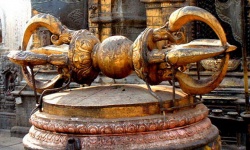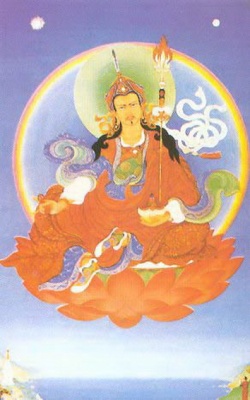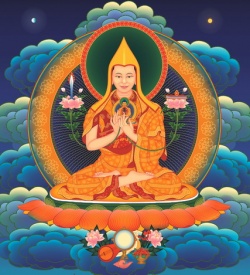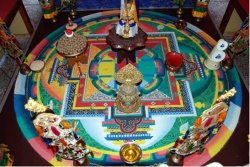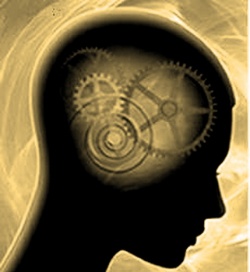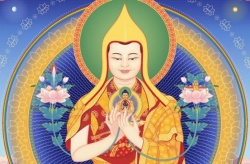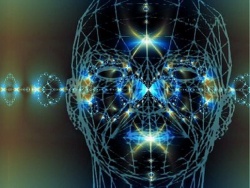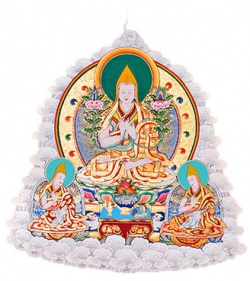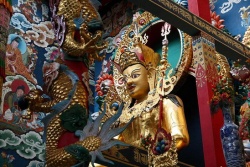Interview with Khenchen Rigdzin Dorje on the Nyingmapa View
Khenpo Rigdzin is one of the closest disciples of one of the greatest Dzogchen yogis of this century, Chatral Rimpoche, who is also one of my Gurus. In 1994, Punya Parajuli and I went to the Nyingma College (Shedra) in Hati Gauda, Kathmandu, to interview him to refine and sharpen our own views from the Nyingma pespective. He was then the Dean of the College.
Ratnashree (Mahayogi Sridhar Rana Rimpoche): What is the conventional truth in the Nyingma system vis-à-vis Tsong Khapa (1357- 1417) the founder of the Gelug school, view of the conventional truth?
Khenpo: Different schools define the conventional truth in different ways according to the Madhyamika. According to Tsong Khapa, the conventional truth exists but according to the Nyingma view, the conventional truth does not exist but appears like a magic, like an illusion, like a dream. We can see or experience but it’s not real. This is the main difference.
Ratnashree: So it does not have existence (Yodpa/Bhava or Satta)?
Khenpo: No. But Tsong Khapa says it exists by itself out there, out of the mind. But according to the Nyingma view, we say everything is empty, nothing exists outside, on its own side. Like a dream when we are dreaming, we can see, we can hear, we can experience everything but it does not really exist outside on its own independently.
Ratnashree: So it just appears?
Khenpo: Yeah, it just appears. It’s the appearance of the mind. But it is not the mind per se. Like the table is the appearance or vision of the mind but the table is not the mind per se (as it has no awareness).
Ratnashree: The conventional truth appears?
Khenpo: Yes, it appears but it is not the mind. We can say the table is the vision/appearance of the mind but the table is not the mind. I think when it comes to the conventional truth, only Tsong Khapa is different, other Sakya, Kagyu,Nyingma, they are all the same.
(NB: The Chittamatra School and those who start from the Chittamatra perspective as the starting point, however, say appearance is mind itself. The Zen School says appearance is mind itself, though not in this kind of terminology and the Sakya School begins from this position too.)
Ratnashree: Since the conventional truth is interdependently arisen (pratityasamutpanna) can we say that conventionally it is interdependently produced but ultimately not produced? Or is it not produced even conventionally?
Khenpo: You can say it is produced, in the same way it does appear, when there are causes and condition but it does not exist in itself/on its own/independently (swabhavasiddha or really existing). Like this table. We can see it, experience it but when we try to find the table then we can say that this is the limb, this is the wood, particles etc, but we cannot find the table. Just like that, we can see, hear etc., experience all phenomena but when we go down to its particles, atoms, to find it, we cannot find it. Therefore, we say it’s empty.
Ratnashree: Yes, but emptiness is the ultimate truth and in the conventional truth we say it is produced interdependently. So when we say produced, are we not saying it exists interdependently?
Khenpo: Yeah, it does not exist independently but we can say it exists interdependently or appears interdependently.
Ratnashree: Well, if we say ultimately it does not exist and conventionally also it does not exist, then isn’t that nihilism (ucchedvada)?
Khenpo: Not really. Because we say when we search for all the phenomena, we cannot find it but when we do not investigate/search, it appears. Therefore, we can say it is not the eternalist view or nihilist view. Why is it not eternalist? When we search we find nothing so it’s not permanent, it is not eternal. If we don’t investigate, everything appears. Therefore, we say it isn’t nihilist.
Ratnashree: In the Gelug system Tsong Khapa very clearly says that emptiness is the ultimate truth. Is this true from Nyingmpa point of view?
Khenpo: Yes, emptiness is the ultimate truth.
Ratnasrhee: But when we practice Dzongchen or Mahamudrae say the ultimate truth is Sal Tong Sung Zug that is the indivisibility of luminosity and emptiness?
Khenpo: No, the emptiness aspect in the indivisibility is the ultimate truth. According to the second turning of the wheel, the emptiness is the ultimate truth, and according to the third turning of the Dharma Chakra, the pure vision and the wisdom are called the ultimate truth. For Sung Zug or indivisibility, we can say there are two kinds of Nang Tong Sung Zug, indivisibility of appearance and emptiness. The Nang tong Sung Zug or indivisibility of appearance and emptiness of the Prithagjana (ordinary unenlightened people) and the Nangtog Sung Zug, indivisibility of appearance and emptiness of the Aryas, the enlightened ones (those who have entered the Path of Seeing/Darshan Marga/Thong Lam). These are different, like a Buddha’s pure vision is itself emptiness and that we call Sung Zug. That is the perfect nature and according to the third turning of the wheel, we can say that it is the ultimate truth.
(NB: The Shentongpas interpret the third turning of the wheel slightly different from this official Nyingma view)
Ratnashree: According to the Karma Kagyu Shentong view, there are two luminosities (prabhaswhar). One is the conventional luminosity and there is an ultimate luminosity which exists beyond existing and non-existing. And the ultimate luminosity really exists (and by implication it is not empty which Dolpopa says as much).
Khenpo: According to the Nyingma, the luminosity can be experienced as pure or impure but the ultimate truth is emptiness. We have two types of conventional truth, one is pure and one is impure. The conventional truth of the ordinary man is impure, while the conventional truth of the Buddhas is permanently pure.
Ratnashree: So, salwa/luminosity/prabhashwar is still conventional. It is pure or impure but still conventional?
Khenpo: Yes
Ratnashree: Only emptiness is the ultimate truth?
Khenpo: Yes
Ratnashree: We have 1) self emptiness view, that is Rangtong/Swa Sunya view/Tawa/ Dristi and 2) other emptiness view Shentong/Para Sunya view/Tawa/ Drishti, etc. What is the official Nyingma view (Tawa/Dristi)? What is the view of Longchenpa, Mipham, Jigme Lingpa etc.?
Khenpo: According to the Nyingmapa, we are not Rangtong, we are not Shentong. If you believe only Rangtong, it becomes nihilistic (ucchedvad). If you believe only Shentong, it becomes eternalist (saswatvad). We believe in Sung Zhug/Yuganadh or Abheda (the indivisibility of or unity of clarity and emptiness/ Prabhaswar Sunyata Yuganadha). According to the second turning of the wheel, all the appearance itself is emptiness .That is Rangtong/Swasunyavadin. According to the third turning of the wheel, we can say that there is some pure vision which the Buddha can see. That is called Shentong/Parasunyavadin. But these two are united. Pure vision and emptiness are united primordially. And that is the Sung Zhug view, Abhedavadin or Yuganaddhavadin, ‘Indivisible-ist’ so to say. Therefore, we are not Shentong and not Rangtong.
(NB: Actually when it comes to actual meditation the Sakya meditation view is also what the Khenpo here calls Sung Zhug. Rangtong in the Sakya system actually means that the emptiness of the Prasangika is not abandoned in the ultimate truth and in Sung Zhug this emptiness (niswabhavata) or empty of real self existence is not abandoned. And regarding luminosity/clarity (prabhashwar) being the conventional truth, regardless of whether it is pure or impure, it is also the view of the Mahasiddha Virupa, which makes it the official Sakya view;( prabhaswar/luminosity/clarity/awareness by itself is the conventional truth)
Ratnashree: So pure vision is also empty?
Khenpo: Yes, it is also empty. Yes.
Ratnashree: In this case, when you say pure vision is also empty, is this emptiness the same emptiness that Rangtong is speaking about?
Khenpo: Yes, it is the same.
Ratnashree: It is not a different emptiness?
Khenpo: No, not different emptiness.
Ratnashree: Again, in Rangtong, we have the Svatantrika and the Prasangika. Which form of Rangtong is popular amongst the Nyingma?
Khenpo: the Madhyamika consider the Prasangika as the perfect Rangtong view. The Dzogchen trekcho view as Kadag (primordially pure view) and the Prasangika view is the same. The emptiness is the same, there is no difference.
(NB: It is important to understand that the words primordially pure/Kadag is the Dzogchen terminology for the Prasangica Emptiness)
Ratnashree: So can we say that ancient Nyingmapa Masters like Long Chenpa, Jigme Lingpa, Mipham were all Prasangikas (consequentialists)?
(NB: the Prasangika main view is that the ultimate truth is free from the Tetralemma, that is the four extremes, they are: 1) exists 2) doesn’t exist 3) neither exists nor doesn’t exist and 4) both exists and doesn’t exist)
Khenpo: Yeah, Prasangikas/Thalgyurpas
Punya Parajuli: Shantarakchita was Svatantric?
Khenpo: Shantarakchita was Svatantrika and Kamala Shila was Svatantrika. During the eighth century, when Shantarakchita came to Tibet he spread the Svatantrika view, but later that was gradually replaced by the Prasangika view. But we still study the Madhyamakalankara. But we teach that the Prasangika is the perfect view.
Ratnashree: According to TsongKhapa’s [[Prasangika[[ view, swalakshyana siddha (having a real self- characteristic), swabhava siddha (having self-existence), satya siddha (being real) etc., are the same, they are synonyms. Does Nyingma view agree with this?
Khenpo: Yes. According to the Prasangika, we say they are the same. They are different according to the Svatantrika.
Ratnashree: Does the Nyingma view also agree with that?
Khenpo: Yes, But Tsong Khapa says pramana siddha (logically established is different). But we don’t agree to that. We say they are all the same.
Ratnashree: Now the two expressions Nisprapancha (Tho Dral) and Antamukta (Tha Dral), which expression is used more often in the Nyingmapa School?
Khenpo: They are the same. We tend to use Tho Dral/Nisprapancha more but they are the same. They have more or less the same intent/meaning.
Ratnashree: In many English translations of Dzogchen and Mahamudray often use the word ‘beyond’ as in ‘beyond the two extreme’. In Sanskrit, we use the word ‘Para’ for beyond (akin to the prefix Para in English). But in Buddhist Sanskrit, the word ‘Mukta’, which means ‘free from’ is used rather than ‘Para’ as in beyond. When we use the word ‘beyond’, it implies there is something beyond the two. When we use the word ‘free from’, it does not imply there is something ‘beyond’ the two but just free from the two. Is the English translation wrong or does the Nyingma view actually says there is something beyond the two?
Khenpo: I think we should say ‘free from’ all the extremes of existing and non-existing. It is free from both without a centre beyond those two.
Ratnashree: No third thing beyond the two extremes?
Khenpo: No, no third.
Ratnashree: Could you elucidate what is the Rangtong view according to the Nyingma?
Khenpo: Actually, in Nyingma, we are not in Rangtong, not in Shentong, but according to Tsong Khapa and Sakya Pandita, they believe in Rangtong. Rangtong means all the phenomena is primordially empty of swabhava (of itself). But there are differences between Sakya Pandit and Tsong Khapa. Tsong Khapa says that the conventional truth exists but Sakya Pandita does not agree to that. Sakya Pandita says everything is empty of swabhava and conventionally is only an appearance and does not really exist. And Tsong Khapa says this emptiness is the perfect nature but the Sakyas say that this emptiness is free from all the extremes and thoughts (Tho Dral/Tha Dral) and that is the perfect nature. So the two Rangtongs are a bit different. And according to Nyingma scholars like Mipham Rinpoche, we say every phenomena (Dharma) is empty from the beginning, even if it is Yeshe/Gyan (wisdom), whether it is permanent (tagpa) or impermanent (mitagpa). Everything is empty from the beginning, which is the same as the Sakya view.
Ratnashree: You said that Nyingma view is not Rangtong not Shentong. Is there a name for this view?
Khenpo: We can call it Sung Zhug or indivisibility view (yuganadh). Nangton Sung Zhug/Pratibhasa sunyata yuganaddha, that is indivisibility of appearance and emptiness; De Tong Sung Zhug/mahsukha sunyata yuganaddha, indivisibility of bliss and emptiness; Sal Tong Sung Zhug/Prabhashwar sunyata yuganaddha, indivisibility of clarity and emptiness; and Rig Tong Sung Zhug/ Vidhya sunyata yuganaddha, indivisibility of wisdom and emptiness etc. This view is called Sung Zhug view.
Ratnashree: Again, could you give a short explanation of Shentong from the Nyingma point of view?
Khenpo: According to Shentong, they say this view comes from the third turning of the wheel. They say that third turning of the wheel is the perfect teaching whereas the first and second turning of the wheel are not perfect or complete teaching. They say when the Buddha taught the first turning of the wheel, the disciples were new level beginners, so he taught accordingly. And when he taught the second turning of the wheel, the students were a little more advanced and finally when he taught the third turning of the wheel, the disciples were the best and of the highest level. This is what the Shentongpas believe.
They believe that the Sugata Garbha (Buddha nature) is free from all negative things like negative karma, klesha (emotional defilements) and thoughts. But there is the essence (swabhava) and it exists (has satta in Sanskrit). Shen or Para means “others” which means all negative karma, thoughts and emotional defilements (kleshas). According to Shentong, they believe that all sentient beings have this Buddha nature, which exists. But there are two major kinds of Shentongpa. One type of Shentongpa believe that all sentient beings have Buddha nature and it has all the qualities of the Buddha from the beginning, just as a sun is there behind the clouds with all its qualities, so too all the qualities of the Buddha like the three Kayas are already present in all sentient beings.
Another type of Shentong does not agree with that. They say that all sentient beings have the Buddha nature but it doesn’t exist by itself (swabhavasiddha). It is empty but there is Buddha nature. Sentient beings have Buddha qualities. So there are two kinds of Shentongpas. Jamgon Kongtrul Rinpoche and Dolpopa etc., believe that all sentient beings have Buddha nature from the beginning and it exists by itself that is it is not empty.
(NB: Even though it appears that the Khenpo is saying that the Dolpopa Shentong and the Karma Kagyu Shentong of Jamgon Kongtrul are the same, Jonang Taranatha (1575–1634) has given 21 differences between the Dolpopa Shentong , which does not seem different from the Hindu Vedantic view, and the Karma Kagyu Shentong view which is similar to that of Shakya Chogden. For after all, the seventh Karmapa, Chödrak Gyatso (1454–1506) was a disciple of the Sakya Master Shakya Chogden (1428–1507). Some Nyingma like Minling Terchen (1646-1714), call themselves Shentongpas but when we go through this philosophy, they are not really Shentongpas like Kongtrul Rinpoches (1813-1899) and Dolpopa Sherab Gyaltsen (1292–1361).
Dolpopa was born in the Dolpo region of Nepal and was affiliated to the Sakya School until he developed his Shentong view based on his Kalchakra experiences and proclaimed that no one before him got the correct view and joined and pushed the Jonang School started by the twelfth century master Yumo Mikyo Dorje. Dolpopa was among the first propagator of the Shentong view along with Yumo Mikyo Dorje who was a disciple of Somanath of Kashmir and the third Karmapa Rangjung Dorje (1284–1339), all of them were Kalachakra practitioners. However, the Kalachakra had always been interpreted with the Rangtong or Sung Zug view till then. It is educating to know that even hard core Karma Kagyu Shentongpas admit that Marpa and Milarepa were not Shentongpas).
Ratnashree: So they are the second types of Shentongpas?
Khenpo: Yeah, second type of Shentongpas.
Ratnashree: How is the view of Minling Terchen different from the view of Shakya Chogden (1428–1507), who is also like the Shentongpa? Some Sakyapas call Shakya Chogden, a Shentongpa, while some say he is not really a Shentongpa?
Khenpo: Shakya Chogden’s view is very close to the Kagyupa view and Gorampa has refuted him. According to Shakya Chogden also all beings have Buddha nature and it has all the qualities of the Buddha from the beginning. But Minling Terchen says that there are qualities but they do not really exist, they are also empty.
Ratnashree: The eighth Karmapa Mikyo Dorje (1507–1554) wrote on both Rangtong and Shentong. When he wrote on the Rangtong, he refuted the Shentong using the logic of the Sakya scholar Gorampa Senge and not the logic of Tsong Khapa. Also when the Nyingmapa scholars like Mipham Rimpoche refute Shentong, they also use Gorampa and not Tsong Kahapas. What is the reason?
Khenpo: Gorampa’s view and Nyingmapa’s view and Kagyu view is the same as far as emptiness goes. As far as the ultimate truth goes it’s the same. Tsong Khapa says Mayin Gag/Paryudas Pratishedha (negation with something(emptiness) remaining) is the perfect nature, but according to Sakya, Kagyu, Nyingma, it’s not perfect. That is nihilism. Therefore, Gorampa’s view of the Sakya, Kagyu, Nyingma view of the ultimate truth is the same (which is basically thadral/anta mukta that is free from the extremes).
Punya Parajuli: This view of Paryudas Pratishedha is not found in the Indian Schools?
Ratnashree: This view of Mayin Gag (Paryudas Pratishedha) is not found in Indian Buddhism. This seems to be created only by Tsong Khapa. Is that right?
(NB: Here we need to understand in the context that the concept of Paryudas Pratishedha did exist in the Indian schools as the Sravaka schools like the Sarvastivada and the Theravada do believe that the ultimate atoms of matter called asta kalap (eight-atom unit) remain even after negation and thus they do exist. As the verse found in Majjhima Nikaya Suyyata Vagga, Culla Suyyata Sutta says, ‘Yam hi kho tatta na hoti tena tam suyyam anupassati, yam pana tattha avassitham hoti, tam santam attheti pajanati’ which is found in the Sanskrit text Uttara Tantra also called RatnagotraVibhaga; and the Abhidharmasamuccaya of Asanga as, ‘Yad yetra nasti tam tena sunyam samanupasshyati, yat punar atravashistam bhavati, tad sad yiha sthiti yathabhutam prajanati’.
The above text means, whatever is not found know that to be empty but know whatever remains to be existing. But in this context, the view that emptiness remains after negation of all other things is what is meant as not existing in the Indian Schools. That is why Gorampa called Tsongkhapa’s view as a type of Shentong because the Shentongpas also use exactly this verse to validate their view that an ultimately existing ultimate truth remains after Rangtong has refuted everything else. It should be noted that the sixth canto of the ancient Brihadaranyak Upanishad (dated 800BC to 1200BC) and the Avadhuta Gita 1.25 both state exactly the same thing through the famous ‘neti neti’ logic (not this not this logic), which says that the Brahman is what remains after everything else, that it is not has been negated).
Khenpo: Yes
Ratnashree: What does Ma yin gag (Paryudas Pratishedha) exactly mean?
Khenpo: Me pa means nothingness. He says this nothingness or emptiness is the perfect nature. But we say there is no ‘nothingness’, no existence.
(NB: meaning neither “non-existence” nor “existence” This freedom from all these extremes is the perfect nature that is freedom from the Tetralemma or Chatuskoti vinirmukta).
Ratnashree: Who is the most famous Master who has written the most on the official view of the Nyingma, for example like Gorampa Sonam Senge (1429-1489) is for the Sakyas? In the [[Zun] Zhug]] view, who are the Masters?
Khenpo: Longchenpa (1308–1364), Jigme Lingpa (1730-1798), Patrul Rinpoche and Mipham Rinpoche (1846-1912).
Ratnashree: So in Sung Zhug view, we have unity of Sal Tong (clarity/luminosity and emptiness). Salwa (clarity/luminosity/Awareness by itself) is always conventional (samvritti/kun dzob) and emptiness ((sunyata)]/tongpa) is the ultimate (paramartha satya/don dam); and the unity of the two is Sung Zhug. Can we call the unity of the two the ultimate truth?
Khenpo: Yes, according to the Nyingma interpretation of the third turning of the wheel, we can call it the ultimate truth also.
Ratnashree: Do all Nyingmapas agree that Sal Tong Sung Zhug is the ultimate truth?
Khenpo: Well according to the Madhyamika Nang Tong Sung Zhug, unity of appearance and emptiness is the ultimate truth. According to the Maha Yoga texts Sal Tong Sung Zhug, unity of clarity and emptiness is the ultimate truth. According to the Anu Yoga texts, De Tong Sung Zhug, unity of bliss and emptiness is the ultimate truth and Rig Tong Sung Zhug, unity of wisdom and emptiness is the ultimate truth according to Ati Yoga.
(NB: All these indivisibility or Sung Zhug views are part of the total Lam Dre teachings and practices of the Sakyapa too. And the Nyingma categorization of Maha Yoga, Anu Yoga and Ati yoga are all included in the total Sakya Lamdre instructions. The ultimate result/fruit of the innate primordially pure awareness is the same in Nyingma Dzogchen and the Sakya Lamdre. It is in path that they differ from each other in fine points. This must be learned from a qualified lineage Master. It must be clarified that the innate primordially pure awareness does not mean a really existing awareness like the Hindu Chidghana / Chinmatra /Vigyanaghana but empty awareness and empty as in the Prasangica empty).
Ratnashree: In Ati Yoga, Ngo Tro is the pointing out the nature of mind and you just used the word Rig Tong Sung Zhug, unity of wisdom and emptiness (vidhya-sunyata yuganaddha). But can we say that Nang Tong Sung Zhug, unity of appearance and emptiness (pratibhasa-sunyata yuganaddha), Sal Tong Sung Zhug, unity of clarity and emptiness (prabhashwar-sunyata yuganaddha), De Tong Sung Zhug, unity of bliss and emptiness (mahasukha-sunyata yuganaddha) can also be called Ngo Tro (pointing out the nature of mind), equally?
Khenpo: Yes. In some Dzogchen texts, we do use these words too for the nature of mind and they mean the same although in Dzogchen we usually use the term Rig Tong Sung Zhug or vidhya-sunyata yuganaddha, indivisibility of wisdom and emptiness or awareness and emptiness.
Ratnashree: And here the tongpanyid/emptiness is the same as sunyata/emptiness of the Rangtong view?
Khenpo; Yes, according to Mipham Rinpoche, the Prasangika Madhyamika sunyata/tongpanyid and the Dzogchen sunyata are exactly the same. There is no difference. One hundred percent same.
Ratnashree: Which ancient Indian monastic university did the Nyingma’s link with the most of all?
Khenpo: Nalanda. Shantarakshita, Kamalashila, Padmasambhava were all from Nalanda.
Ratnashree: After Guru Rinpoche, Shantarakshita, Kamalashila, before the starting of the Shyarma (new transmission) which includes Sakya, Kagyu and Khadampa, did many Nyingma Masters go to Nalanda etc. to study like the Shyarma Masters – Drogmi Lotsawa (992-1074), Marpa Lotsawa (1012–1097)?
Khenpo: After Rinchen Zangpo (958–1055), whatever was translated is called Shyarma (new transmission). Before Rinchen Zangpo, the last Lotsawa of the Nyingma was Smirti Gyan. Before that, whatever was translated was called Nyingma. During that time they were not separate as Nyingma or Shyarma. This separation into the old and new schools began later. During Rinchen Zangpo’s time, people would study from teachers of both schools and they did not debate with each other, because the Shyarma had just started and were the minority and most were of the old school. I cannot give you names but there must have been many scholars who went to India, Nepal to study. Many Kathog Lamas have been known to come to Nepal, Sikhim, India to study but we do not have the details. But I believe many Nyingma Gurus have studied in Nepal and India.
(NB: Kathog Monastery is listed in various enumerations as one of the six principal Nyingma monasteries, one of the main lineages of Tibetan Buddhism. It was founded in 1159 by the younger sibling of Phagmodrupa (1100-1170), Kathog Dampa Deshek. The original Gompa fell into disrepair and was rebuilt on the same site in 1656 through the impetus of Tertön Düddul Dorje (1615–72) and the Terton Rigdzin Longsal Nyingpo (1625-1682/92 or 1685–1752). The monastery held a reputation for producing fine scholarship. It is held that prior to the annexation of Tibet by the Chinese in 1951 Katok Monastery housed 800 monks.
Kathog was long renowned as a center specializing in Kama (Kama as opposed to Terma are the Nyingma teachings that came from India or Indian-Nepali Gurus), and as a center for monasticism, although both of these features were disrupted under Longsel Nyingpo (1625–1692). Kathog Monastery became a bastion of the Anuyoga tradition when it became neglected by other Nyingmapa institutions. The 'Compendium of the Intentions Sūtra' (Wylie: dgongs pa ’dus pa’i mdo) the root text of the Anuyoga tradition was instrumental in the early Kathog educational system. Nubchen Sangye Yeshe wrote a lengthy commentary on the Compendium of the Intentions Sūtra rendered in English as 'Armor against Darkness' (Wylie: mun pa’i go cha) It is said that from the time of its founding in 1159 till 1959 when the monks of Kathog fled from Tibet more than 1,25,000 Dzogchen practitioners went into rainbow body/ja lus/indrachap kaya from Kathog alone).
Ratnashree: The Pema Kathang says Guru Rinpoche studied with Humkar Vajra, who was from Nepal (probably Patan). I think he received Vajra Bhairava (Dorje Jigjye) from Humkar Vajra. What else did he receive from Humkar Vajra?
Khenpo: I can’t say … I need to look into the history.
Ratnashree: The Bonpos also have Dzogchen. Would you like to comment on this?
Khenpo: Actually, Bon does not have Dzogchen. In ancient times, there were two types of Bon: black Bon and white Bon. The black Bon used black magic. Padma Sambhava and Yeshe Tsogyal had to face them in debates and magical displays etc. Finally, the king ordered them to leave Tibet. So they dispersed in all four directions. Even now, we have these kinds of black magic in Ladhak and Sino-Tibetan border regions, Kailash regions. This is not Nyingma. And according to Bon tradition itself, there were things like astrology, prayer rituals for land, for commencing building etc., which were useful for the people and were kept as white Bon. These white Bons got Dzogchen teachings from Guru Rinpoche, Vairochana (eighth century). That lineage has continued up to now. But now they claim they have their own Dzogchen. But this is wrong. In the Pema Kathang, we find all the Bon teachers debated with Guru Rinpoche. If they already had the same Dzogchen, then what was there to debate about? Not only Dzogchen, if you go through the Bon literature, you can find Mahamudra and Maha Madhyamika.
Ratnashree: Yes, that’s true. Anuttara Yoga also.
Khenpo. So if you say Dzogchen is Bon, then Madhyamika, Mahamudraa Yoga also become Bon.
Ratnashree: Some Shyarma writers have claimed that the Dzogchen view is the same as the Ha Shang view. How would you like to comment on that?
(NB:There are a couple of points to be considered here regarding the Ha Shang view and the New transmission:
1)Ha Shang is the Tibetan misnomer for the Chinese Hva Shang which means monk. In the Tibetan context it refers to a specific Chinese monk or Master who debated with the Master Kamalashila from India (c. 740-795) and lost in the debate and ever since his view has been considered as the wrong view in Tibetan history. However , it also appears that because of this particular debate, most Tibetan’s through the centuries seem to believe that Ha Shang represented the entire Chinese systems and thus anything coming from China, Korea or Japan was wrong view. Therefore, many Tibetan Masters and their followers believe that present day Zen is the same as Ha Shang, which is historically a big blunder.
2) The main contention in the famous Samye debate was that Ha Shang’s view had no skillful means (upaya) but seem to imply that only on wisdom (pragya) was necessary. This is not true of present day Chinese systems like Chan/Zen, Tien Tai etc which do have many skillful means as part of their practice and follow the Prasangika Madyamika view. In the same note, many Nyingmapas believe that Sakya Pandit (1182-1251) criticized Dzogchen and many Sakyas believe that present day Dzogchen is what Sakya Pandita refuted but this too is a misunderstanding of what Sakya Pandita actually wrote. He too like Kamalashila refuted the Dzogchen without any skillful means which must have still existed in his time and he very specifically called it Gyanag Dzogchen (Chinese Dzogchen) and alongside called Ati Yoga the highest view.
3) It seems that some Nyingmas who had not really read Sakya Pandita properly, in a sectarian blind-spot attitude even went so far as to call Sakya Pandita a Mara Tulku by extrapolating this idea within the terma of Pema Lingpa (1450–1521). These Nyingmas did not seem to understand the far reaching implications of their ideas, because if Sakya Pandita is actually a Mara Tulku then that would automatically make the last Khenpo of Nalanda Sakya Sri Bhadra a Mara Tulku too as it is Sakya Sri Bhadra who honoured Sakya Pandita with the title of Pandita).
Since it was Khenpo Sakya Sri Bhadra who designated the first Karmapa Dusum Khyenpa (1110-70) as the Karmapa, that would also make the Karmapa a Mara Tulku and thus the entire Karma Kagyu teachings as Mara teachings. Hence, that would link all former Khenpos and Masters of Nalanda including Guru Rimpoche and thus the entire Nyingma system as Mara Tulkus system extending all the way back to Sakyamuni himself as a Mara Tulku. Likewise, such an assumption would make Naropa, Marpa and thus the entire Kagyu system a Mara’s system. Since Vikramashila stems from Sakyamuni all its teachers also become Mara Tulkus, including Atisha. Thus the whole of Buddhism stemming from Sakyamuni, the entire Tibetan Buddhism, Nyingma, Sakya, Kagyu and Gelug would be Mara systems!
4) The form of Zen that the Ha Shang of Samye debate represented was called Nitou Zen (Northern Zen) whose views were close to what the Samye Ha Shang represented. Geographically too, Northern Zen was closer to Tibet than Canton where Southern Zen began. This is what Sakya Pandita meant by Gya nag Dzogchen (Chinese Dzogchen) which must have still existed in some parts of Tibet during Sakya Pandita’s time, despite the Samye debate. Today this Nitou Zen has been completely replaced by the Southern Zen of Hui Neng and does not exist even in China. The present day Zen in all its forms, which have become most popular in the West, were found in China as Chan Buddhism; Korea as Sahn Buddhism; Japan as Zen Buddhism; and in Vietnam as Thien Buddhism These are as different from Nitou Zen as present day Dzogchen is from Gya nag Dzogchen, in that both are replete with skillful means, which was the contention in the Samye debate and in Sakya Pandita’s refutations.
5) The second dissemination (Shyarma) also called the new transmission or the new translation, of Tibetan Buddhism was brought about by Yeshe O, who was the king in the western part of Tibet. The lineage of lay Vajrayana practitioners still survived after the dark age of Tibetan Buddhism, though the monastic and scholarly forms were severely destroyed. Many influential rulers in western Tibet desired to re-establish the entire Tibetan Buddhism. They sponsored translators to India as well. Thus, the second period of transmission of Buddhism in Tibet is often called "the period of the new translations”.
In 1042, the king invited the renowned scholar, Atisha Dipankara Shrijnana (AD 979-1053). He set out a graduated path to enlightenment, known as Lam-rim, stipulated in his book "The Lamp of the Path to Enlightenment”. He also reformed the monastic disciplines, particularly the mentor-student relationship of Lamas and disciples. Being the master of the second transmission of Buddhism in Tibet, his works had a great impact on Tibetan Buddhism, not just in the royal family but also the society. He transformed the warrior-like Tibetans into Buddhists seeking for peace. With his effort, Buddhism was firmly established in Tibet.
This period marked the development of major schools in Tibetan Buddhism and distinguished between the old and the new transmission periods. More sutras were translated, more monasteries were built and more Buddhists entered Tibet on pilgrimages).
Khenpo: This debate is very old. A few centuries ago, some writers said that but now it’s over. Those who did not understand the exact view of Dzogchen used to say that. But according to Ha Shang, their view is that if you want to meditate, don’t think anything. Just keep your mind free from all thoughts, just keep it quiet. That is the perfect meditation. Then we can understand the perfect nature. But Dzogchen is not like that. It is the same as Madhyamika. (NB: And it has many skillful means).
Ratnashree: So Dzogchen is not just being aware without thoughts or remaining in thoughtless non conceptual pure awareness but you have to know the nature?
Khenpo: Yes. Yes! It is not just that.
Ratnashre: Even in India, today we have many schools who say just remaining without thoughts, choice-less awareness, just awareness (chidghana), pure awareness by itself (chinmatra) etc. as the correct view. Many Western people think this is the same as Dzogchen. Do you agree?
Khenpo: Unless you have understood the nature of mind, just remaining thoughtless or choice less awareness is not Dzogchen. Remaining in the nature of mind is Dzogchen, not just remaining in thoughtless non conceptual awareness.
(NB: The Hindu Vedantic practice as advocated by perhaps the most respected and accepted Sri Sankaracharya (788 CE - 820 CE) instructs that the only way to enlightenment is to remain in the non dual, non conceptual awareness that is the watcher/witness/ knower ([[advaita [nirvikalpa drasta]]) which is one’s true identity (Atman) and the only reality while everything else is an illusion. ‘Brahman satyam jagan mithya’, i.e., Brahman the non dual and non conceptual awareness is the real truth while the Samsara is an illusion. This view was not created by Sri Sankaracharya around the 8th century but already existed clearly in the Brihadaranyak Upanishad which is dated to be anytime from 800BC to 1200BC. In the Brihadaranyak Upanishad it says very clearly ‘ppEko drastadvaito bhavati’ meaning ‘ppit is the one non dual awareness’ (Brihadaranyaka Upanishad IV, 3. 32). Dolpopa’s( 1292 - 1361) Shentong view appears to be ditto with slight modifications of this Vedantic view as his main thesis is that thoughts are not Mahamudrat Samsara is not Nirvana and that Samsara is an illusion which does not exist and is therefore empty. But the ultimate non dual awareness exists and is therefore not empty and can never be one with Samsara and by implication thoughts can never be Mahamudra as the Karma Kagyupa teaching says.
This view makes the whole of Buddhist Tantra which is the way of transformation impossible since Samsara, and by implication thoughts, the five aggregates, the 12 faculty gates and the sixteen constituents (skandhadhatvayatanani) can never be transformed into the primordial wisdom or the five Buddhas. This view makes all of Buddhist Tantra irrelevant as Samsara which can never be indivisible with Nirvana because one is empty of real existence (nisvabhava) and the other is not empty and really exists (sat); can never be transformed into primordial wisdom and thoughts can never become Mahamudra.
This Hindu Vedantic type of thesis of Dolpopa contradicts the root Tantras like the Hevajra Root Tantra which says, ‘precisely this is known as Samsara, and precisely this is Nirvana itself. After rejecting Samsara, Nirvana will not be realized elsewhere.’ The two part Hevajra Tantra 2.4.38 states ‘ami Dharmas tu nirvanammohat samsararupina,’ meaning all these Dharmas Samsar) are Nirvana but because of delusion they appear as Samsara. Dolpopa’s view also contradicts the teachings of the Aryas (enlightened ones) of Jambudvipa like Arya Nagarjuna who says in his Magnum Opus the Mulamadhyamaka Karika, chapter 25, Nirvana Parikshya (examination of nirvana verses 19-20) ‘there is no special distinction of Samsara from Nirvana and there is no special distinction of Nirvana from Samsara. There is not the slightest difference between Nirvana and Samsara.’ Also, ‘you do not accept a Nirvana where Samsara has been rejected.’ In the Dharmadhatu Stava, it is said that ‘total transformation is explained as dharmakaya,’ therefore the question arises, what is totally transformed in the Shentong thesis of Dolpopa. If Samsara which is unreal cannot be transformed into Nirvana that is “really existing”, there is nothing to transform but only to realize the ever separate ultimate wisdom like the Hindu Brahman.
This is exactly the view of Sri Sankaracharya. It must also be clarified that these concepts were not taken by Sri Sankaracharya from the Mahasiddhas as some misinformed Buddhists would like to believe, but already existed in the Chandogya Upanishad and Brihadaryanaka Upanishad, dated from 800BC to 1200 BC by Ranade based on linguistic and ideological development and even earlier by some. These texts mention very clearly that Dwitiyam Nasti meaning there is no second but only this Brahman/Atman. And this is the Non dual Awareness/‘Eko drastadvaito bhavati’. All else is an illusion. Sankaracharya based himself on these Upanishads most of which were older than the Buddha himself and definitely did not learn these view from Buddhist Mahasiddhas, as some Western Shentongpas try to push forth.}
Ratnashree: So remaining only in the awareness, thoughtless, choiceless without knowing the nature of mind is the Ha Shang view?
Khenpo: Yes! That is what Kamalashila refuted about the Ha Shang. Kamalshila said that remaining in such a blank, thoughtless awareness is ignorance (moha). You have to discriminate or distinguish the nature of mind, nature of phenomena.
(NB: This is exactly what Sakya Pandita meant when he refuted what he called Chinese Dzogchen and said that due to cultivating this Moha/Ignorance predominated awareness state , it can become a means to be born either as a Naga or in the Formless Realm/Arupa Dhatu, which is something that every bodhisattva tries to avoid.This is avoided in modern Zen through Koans/Kung ans/ Kong ans which is a unique form of Vipashyana/Lhag thong within the Zen school. Even the Soto school which seems to lean towards remaining quietly in a thoughtless non conceptual mind does have what the founder of Japanese Soto School, Dogen Zenji (1200 - 1253), calls Genjo Koans or everyday Koans)
Ratnashree: So it is not enough to be just thoughtless, non conceptual?
Khenpo: No, being non conceptual, thoughtless is not enough. Even a small child is also concept free; Samadhi (one pointed absorption related to samatha) is also concept less, the unconscious state is also thoughtless, non conceptual, a piece of stone is also concept-less/thoughtless. That’s not the correct Dzogchen view. In Dzogchen teaching, the teacher asks the student where is the mind etc, and you should search, the same as in Madhyamika. There is no difference.
(NB: In Zen too the Master asks “show me your mind “and one has to “show” one’s mind to the Master after intensive searching and one is corrected if one is wrong in a typical Zen style)
Ratnashree: The main difference here is there must be Vipashayana. Without Lhagtong (Vipashayana) togme (concept-less/non conceptual) is not enough?
Khenpo: Yes, that is not enough.
(NB: according to the Abhidharmic classification there are two types of avikalpa/tog me (non conceptual state), they are the anashrava avikalpa that is the non conceptual state free from the outflows or defilements and sashrava avikalpa, that is the non conceptual state withflows or defilements. Many people are hopelessly confused by the word “non conceptual” assuming that just being “non-conceptual” is enough. The Abhidharmika teachings make it clear that one cannot jump from defiled conceptual knowledge directly to undefiled non conceptual knowledge but rather one has to move from defiled conceptual knowledge to undefiled conceptual knowledge and from there to undefiled non-conceptual knowledge. The metaphor used is that a larva cannot fly directly but must first transform itself into a butterfly before it can fly into the sky of undefiled non conceptual knowledge. Vajragarbha the lord of the tenth bhumi in his commentery on the Hevajra Tantra called the Satasahasrika Hevajratika 1.51 says very clearly that in the beginning we go by using concepts to conceptual emptiness and finally to the non conceptual emptiness of all the Buddhist ‘adau vikalpadheto savikalpam sunyata phalam bhavet.ante cha sarva Bauddhanam akalpata sunyata phalam. ’There are many kinds of non conceptual states and experiences and they are not the same simply because they are non conceptual experiences. We can have a non conceptual experience of a sour lemon’s taste and also of a sugar candy. Simply because they are both direct non conceptual experiences they do not become the same. In the same way the non conceptual experience of the Brahman is definitely not the same as the non conceptual experience of Emptiness nor do they produce the same results.)
Ratnashree: Thank you very much for your time.
Khenpo: Thank you for coming. I’m very happy.
(All Nota Benes and commentaries are by Ratnashree. All Tibetan words are spelled as they are pronounced)
Sarvarasam Dharmaraso Jayati
His Eminence, Khenchen Rigzin Dorjee Rinpoche is a full lineage holder of the Nyingma tradition. He is the founder and Director of Taktse Nyingma Institute and few retreats and Dharma centers in countries like Bhutan, India, Nepal and USA where he has been teaching extensively over the past 30 years. He has taught in Thailand, Greece, Holland and Canada.
He was highly educated and trained in all major lineages of Nyingma tradition by over 30 well-known Buddhist teachers such as Dudjom Rinpoche, Dilgo Khyentse Rinpoche, Drubwang Pema Norbu Rinpoche, and especially Chatral Sangye Dorje Rinpoche. He is highly proficient in literature, philosophy and religion. After his graduation in 1978 from the Tibetan Institute of Higher Studies in Sarnath (Varanasi) he spent almost ten years as a Khenpo (Professor of Buddhist Philosophy) at Ngagyur Nyingma Institute, founded by Kyabje Pema Norbu and Kyabje Dilgo Khyentse Rinpoche.
Most of his students later became Khenpos, Lopons (Masters of Buddhist Philosophy) and Vajra Masters (Masters of Buddhist Meditation), who now teach all over the world. After founding the Taktse Nyingma Institute in 1988, Rinpoche moved it from Nepal to Sikkim, India in 1996 where he continues to direct it. He spends most of his time teaching at his Dharma centers in USA and Taiwan. Rigzin Dorjee Rinpoche has established two traditional retreat centers in Yolmo, Nepal, with provisions for house eight monks and nuns in separate facilities. He has also founded another retreat center in Martam, Sikkim with facilities for 15 retreatants. He aims to establish more than 100 such small retreat centers.


